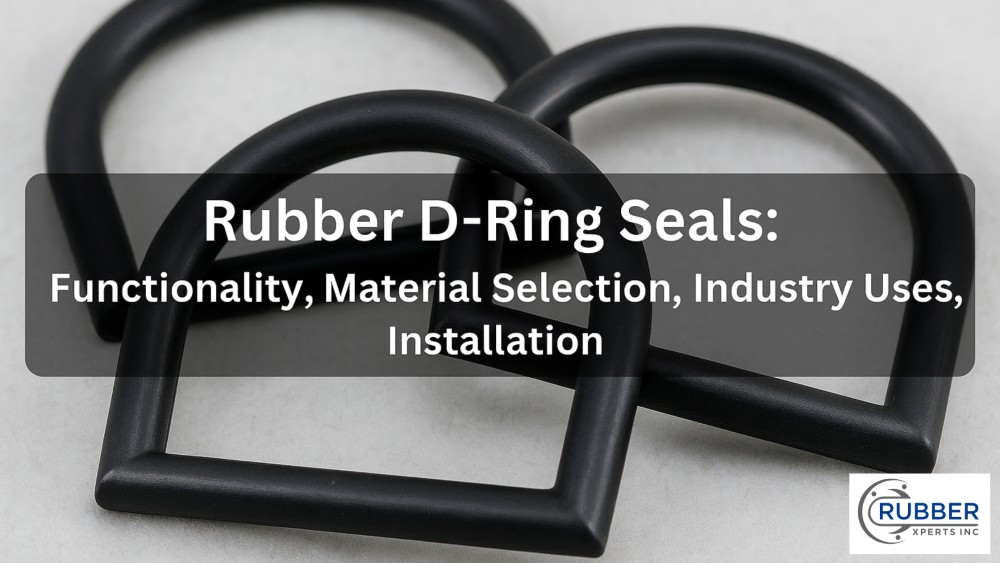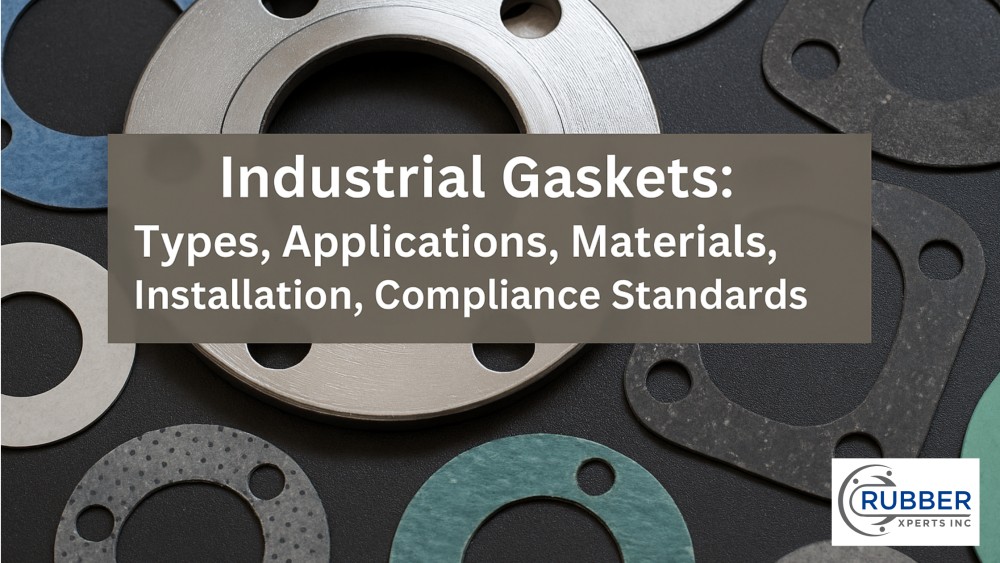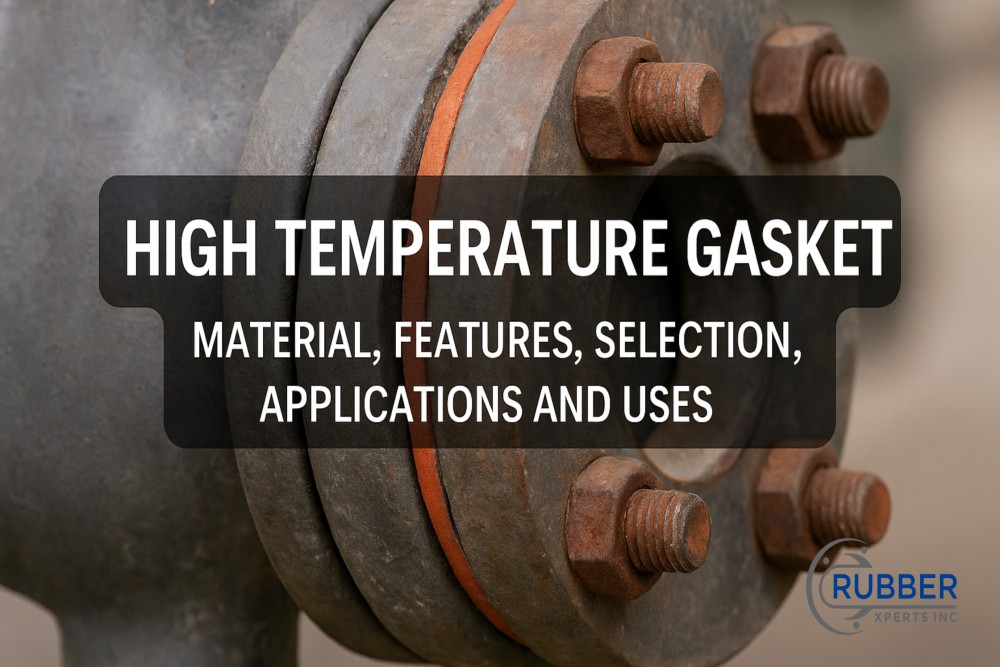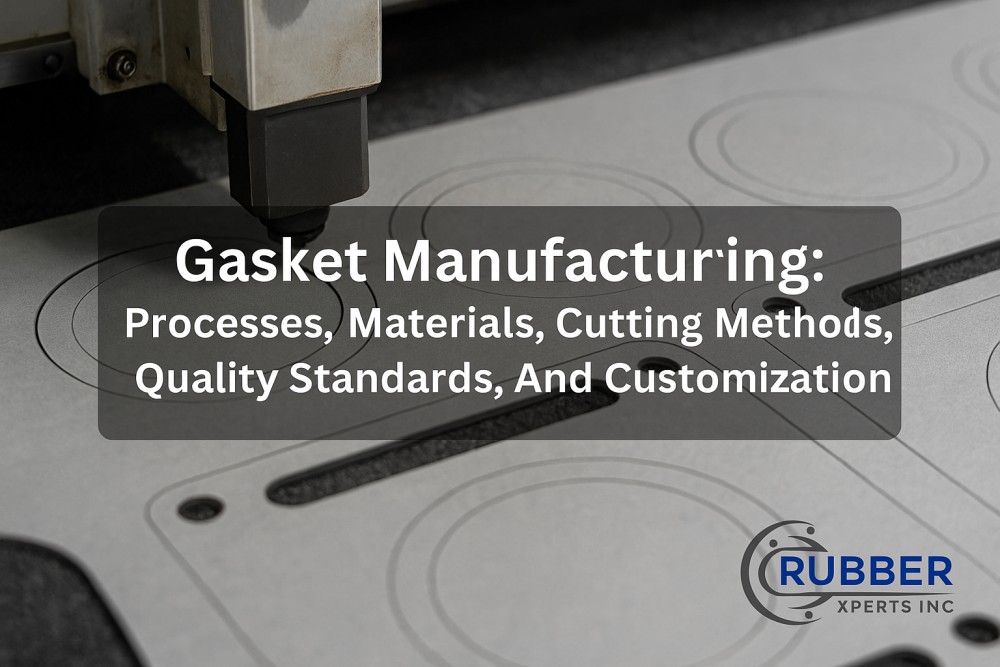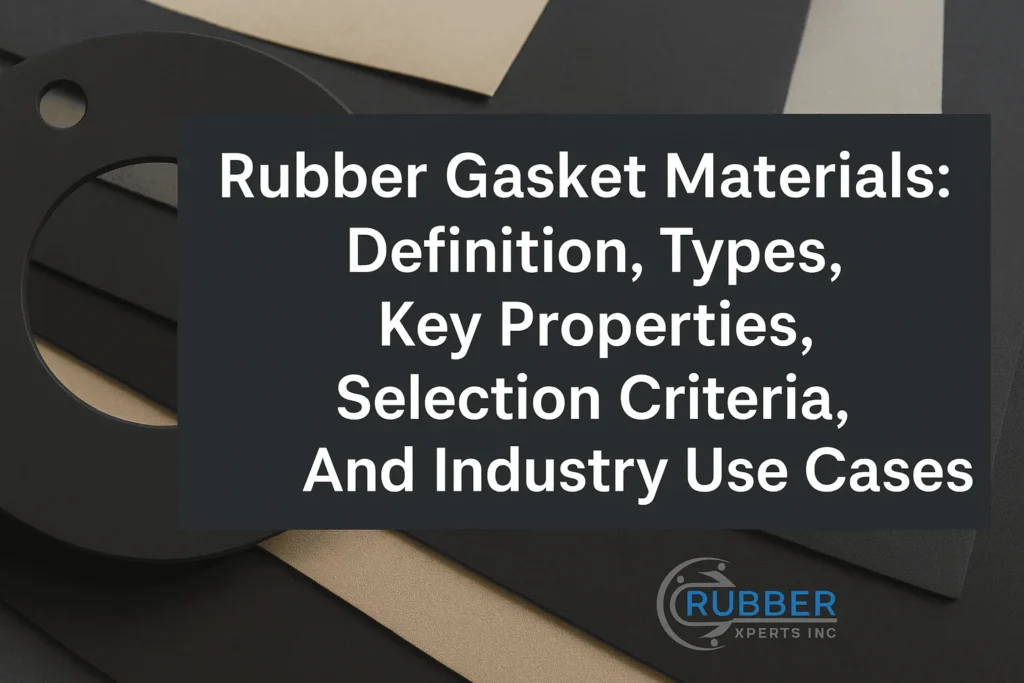Rubber gasket materials combine elasticity, thermal resistance, and chemical compatibility to deliver reliable sealing solutions across a range of fluid sealing technology applications.
Types of rubber gasket materials include neoprene, nitrile, EPDM, silicone, Viton, polyurethane, and food-grade elastomers. Each material addresses specific operational demands through custom-designed gaskets and flexible sealing materials.
Properties of rubber gasket materials include elasticity, compression set resistance, chemical compatibility, abrasion resistance, insulation, and a wide temperature range. These properties ensure the mechanical seals maintain performance across diverse operational conditions.
Selection criteria for rubber gasket materials involve evaluating operating conditions, specific material properties, and application factors, as well as seeking expert advice. Proper material selection maximizes sealing efficiency, extends service life, and ensures regulatory compliance.
Industry use cases of rubber gasket materials include automotive, aerospace, food processing, petrochemical, pharmaceutical, HVAC, plumbing, and electrical. Their application prevents leaks, ensuring longer-lasting industrial systems worldwide.
What Is Rubber Gasket Material?
Rubber Gasket Material is a flexible interface seal made from elastomeric compounds engineered to maintain compression sealing under varying conditions. It functions by creating a barrier between two mating surfaces, preventing leaks in industrial sealing systems where fluids, gases, or contaminants are present.
This material provides consistent sealing integrity by adapting to surface irregularities under pressure, thereby enhancing sealing performance and extending the operational lifespan. The rubber gasket’s function is rooted in its ability to combine resilience with durability across a wide range of sealing applications, including high-pressure and dynamic environments.
Rubber gaskets are used across various sectors that require leak prevention, such as the automotive, food processing, and petrochemical industries. Rubber gasket materials support advanced elastomeric sealing and enable customized designs for specific mechanical or chemical requirements.
These gaskets are foundational to industrial sealing systems, where selecting the right rubber composition ensures effective performance.
What Are The Different Types Of Rubber Gasket Materials?
The different types of rubber gasket materials are Neoprene, Butyl Rubber, Nitrile (Buna-N), Natural Rubber, Ethylene Propylene Diene Monomer (EPDM), Cloth-Inserted Rubber, Silicone Rubber, Polyurethane Rubber, and Viton. Each gasket type is composed of a specific elastomer blend that provides distinct mechanical, thermal, and chemical resistance properties.
The different types of rubber gasket materials are explained below:
Neoprene
Neoprene is a synthetic rubber known for its outstanding resistance to oil, weathering, ozone, and moderate chemicals. Classified as polychloroprene, this elastomer gasket material maintains sealing integrity under a wide range of environmental conditions, making it ideal for flexible sealing solutions in industrial applications.
Neoprene gasket material offers excellent high-temperature resistance up to 250°F (121°C) and good mechanical strength, providing durable rubber gaskets for both static and dynamic sealing systems. Its balanced rubber properties enable consistent compression sealing and effective leak prevention in both indoor and outdoor environments.
Common products manufactured from neoprene include automotive belts, hoses, HVAC gaskets, waterproof gear, and oil-resistant materials used in marine applications. In industrial sealing materials, neoprene rubber gasket designs are widely applied where moderate chemical resistance and weatherproof sealing are required.
Butyl Rubber
Butyl rubber is a synthetic elastomer composed primarily of isobutylene with a small percentage of isoprene, engineered to deliver exceptional impermeability and chemical resistance. It is distinguished by its extremely low gas and moisture permeability, making it one of the most effective sealing solutions for airtight and watertight applications.
Butyl gasket material offers outstanding performance in high-temperature sealing applications, capable of withstanding temperatures of up to 250°F (121°C). The rubber composition enables durable rubber gaskets that maintain flexibility and compression sealing even after prolonged service life.
Common products made from butyl rubber include tire inner liners, pharmaceutical stoppers, gas masks, sealing membranes, and chemical-resistant gaskets used in storage tanks and piping systems. Its unique ability to combine flexibility with impermeability positions butyl rubber as a preferred material in industrial sealing systems demanding long-term reliability.
Nitrile (Buna-N)
Nitrile rubber, commonly known as Buna-N, is a synthetic elastomer derived from acrylonitrile and butadiene, valued for its excellent resistance to oils, fuels, and hydraulic fluids. It serves as a critical material for rubber sealing applications where exposure to petroleum-based substances is frequent.
Nitrile gasket material exhibits strong mechanical properties, including high tensile strength, abrasion resistance, and a functional temperature range between -40°F and 275°F (-40°C to 135°C). Its oil-resistant materials profile makes it a leading choice for sealing systems requiring a reliable rubber gasket function under mechanical stress and fluid contact.
Common products fabricated from nitrile include automotive fuel system gaskets, oil seals, hydraulic hoses, and industrial sealing materials used in petroleum handling facilities. The elastomeric sealing performance of nitrile rubber enables durable rubber gaskets suited for harsh chemical environments where flexible sealing solutions are necessary.
Natural Rubber
Natural rubber is an organic elastomer harvested from the latex sap of the Hevea brasiliensis tree, known for its exceptional elasticity and tensile strength. It forms a cornerstone material for flexible sealing solutions that demand high resilience and dynamic sealing performance.
Natural rubber gasket material offers superior elongation properties, excellent abrasion resistance, and maintains effective compression sealing across a moderate temperature range of -60°F to 175°F (-51°C to 79°C). Its primary advantage lies in outstanding flexibility and tear resistance, although it has limited chemical and weathering resistance compared to synthetic rubber types.
Common products manufactured from natural rubber include industrial gaskets, anti-vibration pads, shock mounts, and rubber seals for mechanical systems operating under low chemical exposure. The rubber composition ensures reliable sealing applications where mechanical durability and the ability to absorb dynamic movement are vital for operational efficiency.
Ethylene Propylene Diene Monomer (EPDM)
Ethylene Propylene Diene Monomer (EPDM) is a synthetic elastomer recognized for its outstanding resistance to weathering, ozone, UV exposure, and a wide range of polar substances, including water and steam. This elastomer gasket material is engineered for industrial sealing systems operating in extreme outdoor and chemical environments.
EPDM gasket material offers high-temperature resistance up to 300°F (149°C) and maintains excellent flexibility at temperatures as low as -70°F (-57°C). Its chemical-resistant gasket profile makes EPDM important in applications exposed to acids, alkalis, and phosphate ester fluids.
Common products made from EPDM include automotive door seals, roofing membranes, weatherproof gaskets, and steam handling seals in food processing and HVAC industries. Its robust rubber properties support flexible sealing solutions where durability under environmental stressors is critical for operational performance.
Cloth-Inserted Rubber
Cloth-inserted rubber is a reinforced elastomer material composed of layers of rubber sheets embedded with fabric such as polyester, nylon, or cotton, designed to enhance mechanical strength and dimensional stability. This construction provides increased tear resistance and improved load-bearing capacity compared to standard rubber gasket materials.
The embedded fabric layers allow cloth-inserted rubber to maintain sealing integrity under higher mechanical stresses, making it ideal for dynamic sealing applications where shear, tensile, and compression forces are consistently applied. It also improves bolt retention during installation, ensuring consistent sealing performance in industrial systems.
Common products manufactured from cloth-inserted rubber include industrial gasket materials for flanged joints, diaphragms, chute linings, conveyor belts, and heavy-duty rubber seals for equipment subjected to pressure cycling. This elastomer gasket option is widely used in the water treatment, mining, and material handling industries, which require durable rubber gaskets with reinforced mechanical properties.
Silicone Rubber
Silicone rubber is a synthetic elastomer based on silicon-oxygen molecular chains, engineered for exceptional thermal stability, flexibility, and biocompatibility. It maintains elastomeric sealing properties across one of the broadest operating temperature ranges, from -80°F to 450°F (-62°C to 232°C), without significant degradation.
Silicone gasket material is renowned for its exceptional high-temperature resistance, resistance to UV light, ozone, and oxidation, as well as its low chemical reactivity. It also retains elasticity and compression sealing performance over time, making it suitable for both static and dynamic industrial sealing systems.
Common products manufactured from silicone rubber include medical device seals, food processing gaskets, oven door gaskets, aerospace seals, and electrical insulation materials. In critical environments requiring both heat-resistant gaskets and flexible sealing solutions, silicone rubber supports consistent rubber gasket function while offering extended material longevity.
Polyurethane Rubber
Polyurethane rubber is an elastomer derived from polymerized urethane compounds, recognized for its exceptional abrasion resistance, load-bearing capacity, and toughness. It bridges the performance gap between plastic materials and traditional rubber gasket types by delivering superior mechanical durability under dynamic and abrasive conditions.
Polyurethane gasket material provides strong tensile strength, high elongation at break, and resistance to oils, greases, and moderate chemicals. It sustains sealing performance across a temperature range of -50°F to 200°F (-46°C to 93°C), while maintaining flexible sealing solutions in high-impact environments.
Common products manufactured from polyurethane rubber include scraper blades, hydraulic seals, industrial gaskets for mining equipment, custom gasket designs for conveyor systems, and protective linings in material handling industries. This elastomer gasket type is extensively used where durable rubber gaskets must withstand severe mechanical stress, abrasion, and repetitive movement.
Viton
Viton is a premium-grade fluoroelastomer developed by DuPont, engineered for superior chemical resistance, heat resistance, and long-term sealing integrity in aggressive environments. This synthetic rubber gasket material retains its elastomeric sealing properties even under exposure to hydrocarbons, strong acids, solvents, and elevated temperatures.
Viton gasket material operates effectively across a broad temperature range, from -15°F to 400°F (-26°C to 204°C), while specialized grades extend performance up to 600°F (315°C). It offers outstanding resistance to compression set, ensuring consistent sealing performance and reduced maintenance cycles in harsh chemical and thermal conditions.
Common products manufactured from Viton include automotive fuel system gaskets, aerospace seals, chemical processing gaskets, oil and gas seals, and heat-resistant gaskets for industrial applications. Viton supports custom gasket designs that require flexible sealing solutions to combine chemical resilience with high-temperature endurance for critical industrial sealing applications.
Food Grade (FDA Approved) Rubber
Food-grade rubber is a specialized elastomer material formulated to meet the safety and purity standards established by the U.S. Food and Drug Administration (FDA) for direct contact with food products. It is designed to provide flexible sealing solutions that do not contaminate consumables during processing, packaging, or storage.
Food grade gasket material offers excellent resistance to water, mild cleaning chemicals, and varying temperatures, depending on the rubber composition, with common ranges between -40°F and 400°F (-40°C to 204°C). It is free from harmful additives and toxins, ensuring that sealing applications maintain food safety integrity while delivering reliable leak prevention in hygienic environments.
Common products manufactured from food-grade rubber include sanitary gaskets, beverage dispensing seals, dairy tubing, pharmaceutical processing gaskets, and seals for food handling equipment.
Styrene Butadiene Rubber (SBR)
Styrene Butadiene Rubber (SBR) is a synthetic elastomer made from the copolymerization of styrene and butadiene, engineered for strong abrasion resistance, flexibility, and cost-effectiveness. It stands as one of the most widely used synthetic rubber gasket materials for general industrial applications.
SBR gasket material delivers excellent resilience, good impact strength, and operates efficiently within a temperature range of -40°F to 210°F (-40°C to 99°C). Although it lacks the oil and chemical resistance found in materials like nitrile or Viton, its low cost and high durability make it suitable for sealing applications that involve mechanical stress and exposure to water.
It supports a consistent rubber gasket function in moderate environments that require large-volume installations.
Common products manufactured from SBR include conveyor belt gaskets, water pump seals, industrial mats, flexible sealing solutions in plumbing, and automotive brake system components.
What Are The Key Properties Of Rubber Gasket Materials?
The key properties of rubber gasket materials include elasticity and compressibility, adhesion, abrasion, resistance, a suitable temperature range, and insulation. These properties determine how well a rubber gasket performs in industrial sealing systems under mechanical, thermal, and chemical stresses.
The key properties of rubber gasket materials are as follows:
Elasticity And Compressibility
Elasticity is the ability of a rubber gasket material to deform under stress and return to its original shape once the stress is removed. This property ensures tight surface conformity, promoting leak prevention and sealing performance even under dynamic loads.
Compressibility measures how well a material compacts under pressure without losing sealing integrity. Higher compressibility improves surface coverage, enabling effective flexible sealing solutions across rough or uneven industrial surfaces.
Materials with enhanced elasticity and compressibility maintain sealing performance over longer cycles, reducing maintenance intervals in sealing applications.
Adhesion
Adhesion is the ability of a rubber gasket material to bond or cling effectively to the surfaces it seals. Strong adhesion minimizes the risk of gasket slippage, ensuring sealing integrity under both mechanical stress and thermal cycling.
It enhances the rubber gasket’s function by ensuring continuous leak prevention, even during the expansion or contraction of sealed components.
High adhesion improves assembly reliability and reduces the need for additional fastening methods in industrial sealing materials. Consistent adhesion has a direct impact on sealing applications where vibration, pressure, and movement are present.
Abrasion
Abrasion is the resistance of a rubber gasket material to surface wear caused by friction, mechanical motion, or contact with rough surfaces. High abrasion resistance ensures that the gasket maintains its sealing integrity over extended operational cycles without material degradation.
It protects flexible sealing solutions from early failure in dynamic industrial sealing systems where parts move against each other. Durable rubber gaskets with strong abrasion properties perform consistently in harsh environments, minimizing downtime and replacement costs.
Resistance
Resistance in rubber gasket materials is the ability to withstand chemical exposure, environmental stress, temperature fluctuations, and mechanical forces without degrading. High resistance ensures that sealing performance remains stable across varying operational conditions in industrial sealing systems.
Materials that exhibit chemical compatibility, temperature resistance, and environmental resistance deliver a longer service life and consistent leak prevention. Resistance properties protect rubber sealing applications from breakdowns caused by oils, solvents, UV light, and ozone.
Temperature Range
The temperature range defines the span of minimum and maximum temperatures that a rubber gasket material endures while maintaining its sealing properties. Gaskets with broad temperature resistance operate effectively in both extreme cold and high-heat environments without losing elasticity or compression set.
Reliable temperature range performance prevents hardening, cracking, or melting under thermal stress. Rubber gasket materials with optimized temperature ranges are critical for sealing applications in automotive engines, food processing, and aerospace.
Insulation
Insulation in rubber gasket materials is the ability to resist the transfer of electricity, heat, or sound across sealed joints. Strong insulation properties protect sensitive components from electrical shorts, thermal losses, and noise transmission in industrial sealing systems.
Rubber gaskets with high insulation prevent system failures and enhance energy efficiency across sealing applications. Insulating elastomer gasket materials are widely used in electronics, HVAC systems, and high-voltage environments.
What Is The Selection Criteria For Rubber Gasket Materials?
The selection criteria for rubber gasket materials include operating conditions, material properties, specific application factors, and expert advice. These criteria define the baseline performance needs, and that all functional demands and safety regulations are addressed during material selection.
The selection criteria for rubber gasket materials are explained below:
Operating Conditions
Operating conditions are the specific environmental and mechanical factors, such as application temperature, pressure tolerance, chemical exposure, and mechanical stress, that a rubber gasket must endure during service. These parameters define the material compatibility required for long-term sealing performance.
Correctly matching gasket materials to operating conditions ensures that the sealing solution meets durability requirements and prevents leaks across industrial sealing systems. Ignoring operating conditions leads to gasket deformation, premature failure, and system breakdowns, particularly under fluctuating environmental conditions or exposure to aggressive chemicals.
Material Properties
Material properties are the inherent physical and chemical characteristics of a rubber gasket, including tensile strength, elasticity, compression set resistance, hardness ratings, and oil resistance. These attributes determine how the gasket reacts under pressure, heat, chemical exposure, and mechanical stress during sealing applications.
Selecting a gasket material with the correct properties ensures that durability requirements are met across various environmental conditions, thereby preventing leakage, deformation, and material breakdown.
The proper evaluation of material properties has a direct impact on sealing performance, mechanical longevity, regulatory compliance, and cost-effectiveness within industrial sealing systems.
Specific Application Factors
Specific application factors are the unique operational demands of a sealing system, including chemical exposure levels, application temperatures, mechanical stress patterns, and environmental conditions encountered during service. These factors dictate the need for customised material compatibility, ease of installation, and pressure tolerance.
Addressing these requirements enhances durability, optimizes cost-effectiveness, and ensures that gaskets perform reliably in specialized industrial sealing applications.
Expert Advice
Expert advice is the professional evaluation and recommendations provided by engineers, materials scientists, or technical specialists during the selection of gasket materials for specific sealing applications.
It incorporates knowledge about material compatibility, regulatory compliance, durability requirements, and cost-effectiveness based on real-world industrial conditions. Expert input directly improves sealing performance, extends service life, and reduces the risk of failures in complex industrial sealing systems.
Seeking expert advice from experienced rubber products manufacturers, such as Rubberxperts, ensures precise gasket selection aligned with real application demands. It offers practical insights into material compatibility, environmental conditions, and durability requirements for industrial sealing systems.
What Are The Industry Use Cases Of Rubber Gasket Materials?
The industry use cases of rubber gasket materials include automotive, aerospace, food processing, petrochemical, pharmaceutical, HVAC, and plumbing, as well as the electronics and electrical sectors. Each industry utilizes specific elastomer gasket types based on material compatibility, durability requirements, chemical resistance, and temperature requirements for the application.
The industry use cases of rubber gasket materials are as follows:
Automotive
The automotive industry relies on rubber gaskets to provide sealing integrity in various components, including engines, transmissions, fuel systems, braking systems, and HVAC units. Rubber gasket materials are selected based on their resistance to oil, temperature, and durability requirements to withstand harsh mechanical stress and chemical exposure.
Rubber gaskets improve vehicle performance by maintaining leak-free connections under fluctuating temperatures, high pressure, and vibration. They ensure environmental resistance against road debris, oils, and fuels, supporting long-term operational reliability and regulatory compliance.
Use Cases Of Rubber Gaskets In The Automotive Industry
Use cases of rubber gaskets in the automotive industry include pipeline flange gaskets, valve and pump seals, as well as applications in refineries and chemical processing plants. Each application demands material compatibility, oil resistance, pressure tolerance, and environmental resistance to maintain long-term sealing performance.
Use cases of rubber gaskets in the automotive industry are:
- Pipeline Flange Gaskets: Pipeline flange gaskets create leak-proof seals between flanged pipe connections, maintaining system pressure and preventing fluid loss. They endure temperature resistance and mechanical stress from fluid dynamics and vibration in automotive cooling and fuel systems. Durable rubber gaskets protect critical pipelines against chemical exposure and material fatigue.
- Valve and Pump Seals: Rubber gaskets are used in automotive valve covers and pump housings to prevent leakage of lubricants, coolants, and hydraulic fluids. High elasticity and compression set resistance help maintain sealing integrity under cyclic thermal expansion and contraction. Reliable valve and pump seals enhance vehicle durability and reduce the frequency of maintenance intervals.
- Refineries and Chemical Processing Plants: In refineries linked to automotive fuel supply chains, rubber gaskets play a critical role in sealing chemical pipelines and processing equipment. Materials selected exhibit high chemical compatibility and oil resistance, enabling the management of aggressive hydrocarbons and process chemicals. Effective gaskets prevent emissions, leaks, and contamination risks during refining operations.
Aerospace
The aerospace industry employs rubber gaskets for sealing components in aircraft engines, fuselage structures, hydraulic systems, fuel systems, and environmental control units. Aerospace operations demand sealing solutions with high temperature resistance, chemical compatibility, low outgassing, and resilience under mechanical stress.
Rubber gaskets in aerospace maintain structural integrity under fluctuating pressures, extreme temperatures, and aggressive chemical environments. They enhance flight safety by ensuring leak prevention across critical systems, including fuel delivery and cabin pressurization.
Use Cases Of Rubber Gaskets In Aerospace
Use cases of rubber gaskets in the aerospace industry include fuel and hydraulic systems, cabin pressure seals, and environmental sealing. These applications demand materials with superior temperature resistance to maintain consistent performance under extreme operating conditions.
Use cases of rubber gaskets in aerospace are explained below:
- Fuel and Hydraulic Systems: Rubber gaskets maintain leak-proof seals in aircraft fuel lines, hydraulic actuators, and fluid reservoirs. High chemical resistance and pressure tolerance prevent fuel leakage and fluid loss during altitude and pressure fluctuations.
- Cabin Pressure Seals: Rubber gaskets are used to secure and stabilize cabin pressure by sealing doors, windows, and structural joints. Materials with low compression set and strong elasticity ensure consistent sealing under temperature cycles and altitude changes.
- Environmental Sealing: Environmental seals protect sensitive avionics, electrical systems, and mechanical assemblies from moisture, dust, ozone, and temperature extremes. Rubber gaskets with environmental resistance properties preserve equipment function in both atmospheric and high-altitude environments.
Food Processing
The food processing industry utilizes rubber gaskets to seal machinery involved in the production, packaging, and storage of consumable goods. Food-grade rubber gasket materials are engineered to meet regulatory compliance standards for purity, hygiene, and chemical inertness.
Rubber gaskets in food processing prevent contamination by maintaining leak-free seals in mixers, pipelines, tanks, and filling equipment. Materials are selected for their chemical compatibility with cleaning agents, resistance to extreme application temperatures, and durability under frequent sterilization cycles.
Use Cases Of Rubber Gaskets In Food Processing
Use cases of rubber gaskets in food processing include seals for food processing equipment, bottle and jar cap gaskets, and those used in dairy and beverage lines. These applications require high-purity rubber materials to ensure a safe and hygienic production process.
Use cases of rubber gaskets in food processing are:
- Seals for Food Processing Equipment: Rubber gaskets are used to seal mixers, grinders, conveyors, and cutting machines in food plants. Food-grade elastomer materials offer chemical resistance to sanitizers and cleaning solutions while maintaining flexibility at high application temperatures.
- Bottle and Jar Cap Gaskets: Rubber gaskets line the caps and lids of bottles and jars, creating air-tight seals that preserve freshness and prevent leakage. Materials selected for these gaskets retain their elasticity and resistance to compression set after repeated opening and closing cycles.
- Dairy and Beverage Lines: Rubber gaskets provide leak-proof seals in dairy processing pipelines, beverage transfer lines, and storage tanks. They offer high temperature resistance during pasteurization and cleaning operations, along with strong material compatibility against milk fats, juices, and carbonated liquids.
Petrochemical
The petrochemical industry uses rubber gaskets extensively to seal pipelines, valves, pressure vessels, and processing equipment involved in the extraction, refining, and transportation of oil and gas. These environments require gasket materials designed for exceptional chemical compatibility, high-pressure tolerance, and robust environmental resistance.
Rubber gaskets in petrochemical operations prevent hazardous leaks, support safe handling of volatile hydrocarbons, and maintain sealing integrity under high mechanical stress. Material selection prioritizes oil resistance, aging resistance, and temperature resistance to ensure system reliability and compliance with regulatory requirements.
Use Cases Of Rubber Gaskets In The Oil And Gas Industry
Use cases of rubber gaskets in the oil and gas industry include pipeline flange gaskets, valve and pump seals, as well as those found in refineries and chemical processing plants. These critical applications require gasket materials with strong chemical compatibility, pressure tolerance, and environmental resistance to sustain harsh operating conditions.
Use cases of rubber gaskets in the oil and gas industry are:
- Pipeline Flange Gaskets: Rubber gaskets seal flanged connections across oil and gas pipelines, maintaining leak prevention under high-pressure and corrosive fluid conditions. Materials are selected for their durability requirements and resistance to temperature and chemical degradation.
- Valve and Pump Seals: Rubber gaskets are used in upstream and downstream valve assemblies, as well as pump housings, to control the flow of hydrocarbons. High oil resistance and compression set resistance ensure effective sealing even under dynamic pressure and temperature fluctuations.
- Refineries and Chemical Processing Plants: In refining and chemical processing facilities, rubber gaskets are important for sealing vessels, reactors, and processing lines. Gaskets must endure exposure to aggressive chemicals, high application temperatures, and mechanical stress.
Pharmaceutical
The pharmaceutical industry relies on rubber gaskets to seal processing equipment, storage systems, and sterile packaging used in the manufacture and distribution of drugs. Gasket materials must meet strict regulatory compliance standards for purity, biocompatibility, and chemical inertness.
Rubber gaskets ensure leak prevention, contamination control, and environmental resistance in pharmaceutical operations. High material compatibility with cleaning agents, disinfectants, and process chemicals preserves product integrity and protects patient health.
Use Cases Of Rubber Gaskets In Healthcare
Use cases of rubber gaskets in healthcare include sterile seals in medical devices, drug manufacturing equipment, and biotech applications. These applications require gasket materials with excellent chemical and biocompatibility, as well as durability, to maintain sterile and controlled environments.
Use cases of rubber gaskets in healthcare are:
- Sterile Seals in Medical Devices: Rubber gaskets are used in surgical instruments, diagnostic equipment, and implantable devices to create sterile barriers. Materials must resist degradation from sterilization cycles such as autoclaving and gamma radiation.
- Drug Manufacturing Equipment: Rubber gaskets seal mixers, reactors, and transfer systems involved in pharmaceutical production. High chemical resistance ensures compatibility with active pharmaceutical ingredients and cleaning agents used in manufacturing.
- Biotech Applications: Rubber gaskets are integrated into bioreactors, filtration units, and laboratory equipment used in biotechnology research and production. Materials selected must be able to tolerate exposure to biological media, sterilization, and mechanical stress without compromising sealing performance.
HVAC And Plumbing
The HVAC and plumbing industries utilize rubber gaskets to seal ducting systems, pipe joints, valves, pumps, and other mechanical equipment involved in the transport of fluids and air. These systems require gasket materials engineered for application temperature stability, pressure tolerance, and chemical compatibility with water, coolants, and air mixtures.
Rubber gaskets in HVAC and plumbing prevent fluid leaks, maintain system pressure, and support energy efficiency by sealing critical joints and components. High durability requirements and environmental resistance ensure that seals withstand temperature cycles, mechanical stress, and chemical exposure.
Use Cases Of Rubber Gaskets In Plumbing
Use cases of rubber gaskets in plumbing are duct and pipe seals, water heater gaskets, and pump seals. These applications require gasket materials with strong durability, temperature resistance, and chemical compatibility to ensure long-lasting and leak-free operation.
Use cases of rubber gaskets in plumbing are:
- Duct and Pipe Seals: Rubber gaskets are placed between duct joints and pipe flanges to prevent air and water leakage. Materials with strong elasticity and pressure tolerance adapt to system expansion and contraction during temperature changes.
- Water Heater Gaskets: Rubber gaskets seal connections in water heater tanks, valves, and heating elements. High-temperature resistance and chemical exposure protection are critical to maintaining leak prevention during heating cycles.
- Pump Seals: Rubber gaskets form critical seals in plumbing pump assemblies, preventing leakage of water and coolant fluids. Gaskets with strong mechanical stress resistance handle system pressure variations without losing sealing integrity.
Electronics And Electrical
The electronics and electrical industries rely on rubber gaskets to seal enclosures, connectors, switches, and sensitive components against moisture, dust, electromagnetic interference, and temperature extremes. These applications require gasket materials with strong environmental resistance, insulation properties, and material compatibility with electronic substrates.
Rubber gaskets protect electronic systems from contamination, corrosion, and short-circuiting by maintaining consistent sealing integrity. High durability requirements and temperature resistance ensure reliable operation even in fluctuating environmental conditions.
Use Cases Of Rubber Gaskets In The Electric Industry
Use cases of rubber gaskets in the electric industry are insulation for enclosures, EMI/RFI shielding gaskets, and moisture seals in devices. These applications demand gasket materials with excellent insulation properties, environmental resistance, and durability requirements to maintain system protection and functionality.
Use cases of rubber gaskets in the electric industry are:
- Insulation for Enclosures: Rubber gaskets provide electrical insulation in control panels, junction boxes, and switchgear enclosures. High dielectric strength and temperature resistance prevent electrical arcing, protecting sensitive circuits.
- EMI/RFI Shielding Gaskets: Rubber gaskets embedded with conductive materials block electromagnetic interference (EMI) and radio-frequency interference (RFI). Effective shielding ensures that electronic devices maintain signal integrity and comply with regulatory electromagnetic compatibility standards.
- Moisture Seals In Devices: Rubber gaskets seal electronic device housings against moisture, dust, and airborne contaminants. Strong environmental resistance prevents corrosion, short circuits, and mechanical failures caused by humidity or exposure to fluids.
What Is The Importance Of Selecting The Right Gasket Material?
The importance of selecting the right gasket material lies in ensuring sealing reliability, maintaining chemical compatibility, extending service life, enhancing operational safety, and reducing maintenance costs. Each factor directly influences the performance and longevity of industrial sealing systems.
Below is a table summarizing the importance of selecting the right gasket material:
| Importance Factor | Description |
| Sealing Reliability | Prevents leaks, pressure loss, and contamination across mechanical joints and fluid systems. |
| Chemical Compatibility | Ensures gasket material resists breakdown when exposed to oils, chemicals, or aggressive media. |
| Extended Service Life | Reduces gasket replacement frequency by withstanding thermal, mechanical, and chemical stresses. |
| Operational Safety | Maintains system integrity, preventing accidents and equipment failures. |
| Reduced Maintenance Costs | Reduces gasket replacement frequency by withstanding thermal, mechanical, and chemical stresses. |
What Type Of Rubber Is Used In Gaskets?
The types of rubber used in gaskets include neoprene, nitrile (Buna-N), natural rubber, EPDM, silicone, Viton, polyurethane, and food-grade elastomers. Each rubber composition is selected based on the application temperature requirements, chemical compatibility, pressure tolerance, and durability factors that are critical across industrial sealing systems.
The types of rubber used in gaskets are explained below:
- Neoprene: Offers excellent environmental resistance against weathering, ozone, and moderate chemicals. Commonly used in HVAC systems, automotive parts, and industrial sealing applications exposed to outdoor conditions.
- Nitrile (Buna-N): Provides strong oil resistance and mechanical durability. Selected for fuel systems, hydraulic applications, and environments where petroleum-based fluids are present.
- Natural Rubber: Delivers outstanding elasticity and abrasion resistance under mechanical stress. Suitable for dynamic sealing applications in low chemical exposure environments.
- EPDM: Excels in resistance to water, steam, UV light, and a range of polar chemicals. Used heavily in automotive seals, roofing systems, and water-handling equipment.
- Silicone: Maintains flexibility and sealing integrity over extreme temperature ranges. Chosen for medical, food processing, and high-heat applications where biocompatibility and cleanliness are priorities.
- Viton: Provides exceptional chemical resistance and high temperature stability. Preferred for sealing systems exposed to aggressive chemicals and extreme thermal cycles in aerospace and petrochemical industries.
- Polyurethane: Combines high abrasion resistance with good mechanical strength. Applied in material handling, mining, and industrial systems where impact and wear protection are critical.
- Food-Grade Elastomers: Specially formulated to meet FDA and regulatory standards for purity and safety. Used in food and beverage production, pharmaceutical manufacturing, and sanitary processing environments.
What Is The Most Commonly Used Material For A Gasket?
The most commonly used material for gaskets is Nitrile (Buna-N) rubber. This synthetic elastomer offers exceptional oil resistance, high tensile strength, good compression set resistance, and material compatibility across various automotive, aerospace, and industrial sealing systems.
According to a study by T.A. Buia and X.N. Trana titled “Analyzing Pneumatic Cylinder Service Life through Seal Material Selection, Simulation, and Experimentation” published in the journal Tribology in Industry (2025), Nitrile (Buna-N) rubber remains the most commonly used material for industrial gaskets, especially in systems exposed to oils, achieving a 35% reduction in leakage rates compared to ordinary rubber.
Nitrile rubber gaskets maintain sealing integrity across a wide range of application temperatures, from -40°F to 275°F (-40°C to 135°C), meeting durability requirements that outperform those of ordinary rubber materials.
High resistance to fuels, oils, and hydraulic fluids makes nitrile the preferred choice in environments where chemical exposure and mechanical stress are constant. Selecting nitrile gaskets improves leak prevention, reduces maintenance costs, and extends system reliability in both static and dynamic sealing applications.
What Is The Difference Between A Rubber Seal And A Rubber Gasket?
The difference between a rubber seal and a rubber gasket lies in their primary functions: rubber seals prevent leakage along moving parts, while rubber gaskets create static seals between stationary components.
Both rubber seal and rubber gasket operate under different mechanical conditions. Each serves a distinct purpose in industrial sealing systems.
Below is a table illustrating the differences between a rubber seal and a rubber gasket:
| Feature | Rubber Seal | Rubber Gasket |
| Function | Prevents fluid leakage along moving surfaces | Creates a static barrier between stationary parts |
| Common Applications | Shafts, pumps, rotating equipment | Pipe flanges, covers, and engine blocks |
| Mechanical Stress Handling | Designed for dynamic movement and pressure changes | Designed for static compression and surface conformity |
| Material Requirements | Higher elasticity and abrasion resistance | Higher compressibility and surface adaptability |
| Examples | O-ring seals, shaft seals, lip seals | Flange gaskets, head gaskets, and enclosure gaskets |
What Are The Leading Machines For Producing Rubber Gaskets?
The leading machines for producing rubber gaskets include the FlashCut Gasket Cutting System, Fiberforge Machine, Zemat RCE Gasket Cutting Machine, Compression Molding Presses, and the Rolmacon Gasket Die Cutting Machine.
These machines are engineered to meet industrial standards for precision cutting, material compatibility, and production efficiency in gasket manufacturing.
The leading machines for producing rubber gaskets are:
- FlashCut Gasket Cutting System: The FlashCut system uses automated blades or waterjets to cut precise gasket shapes from rubber sheets with minimal material waste. It supports flexible sealing solutions across a range of rubber compositions by adjusting cutting speed and pressure tolerance.
- Fiberforge Machine: The Fiberforge machine automates the production of layered composite gaskets, enhancing material durability and mechanical stress resistance. This system is used for manufacturing durable rubber gaskets in aerospace and heavy-duty industrial sealing applications.
- Zemat RCE Gasket Cutting Machine: The Zemat RCE system utilizes oscillating blades and programmable software to achieve clean cuts on thick or multi-layered gasket materials. It provides strong material compatibility, accommodating rubber, silicone, and other elastomer sheets with complex geometries.
- Compression Molding Presses: Compression molding presses form gaskets by pressing uncured rubber into custom-designed molds under controlled heat and pressure. Compression molding is preferred for producing specialized industrial sealing materials and complex rubber gasket shapes.
- Rolmacon Gasket Die Cutting Machine: The Rolmacon die-cutting machine utilizes hardened steel dies to stamp gasket shapes from rubber sheets efficiently. Rolmacon machines are widely used for the mass production of standard industrial gaskets, meeting the durability requirements of large-scale operations.
Where To Get High-Quality Rubber Gaskets?
To get high-quality rubber gaskets requires using manufacturers who specialize in precision gasket design, material selection expertise, and adherence to industrial sealing standards.
For trusted solutions, Rubber Experts offers custom manufacturing of Rubber Gaskets engineered to meet specific environmental resistance, chemical compatibility, and operational demands.
Our extensive knowledge of elastomer gasket materials and advanced production technologies ensures flexible sealing solutions customized to industrial needs while maintaining consistent sealing performance and quality assurance.

